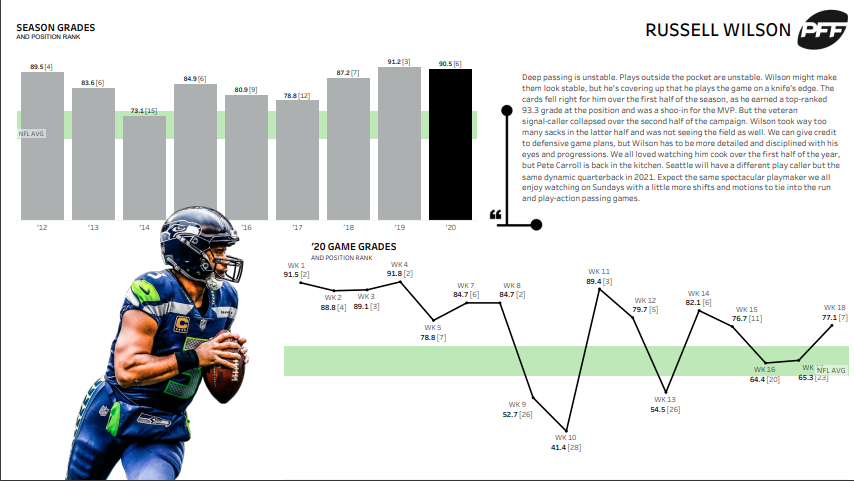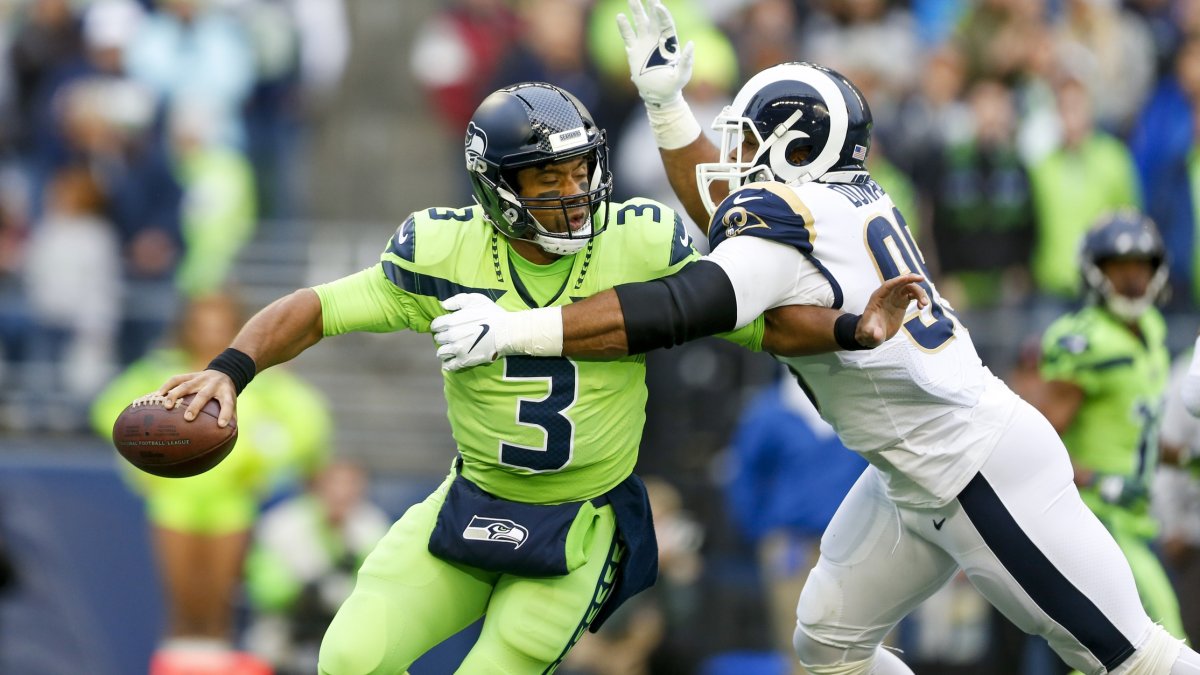Letting Russ cook is all well and good, but what meal should he be trying to make?
The Seattle Seahawks signal-caller remains one of the biggest enigmas at the quarterback position in the league, an intriguing puzzle for his coaching staff to solve as we head into the 2021 NFL season. And the biggest question with Wilson, as it always has been, is what is the best style of play to employ for a player with his unique skill set?
Subscribe to
Wilson is primarily responsible for the league reassessing its strict height requirements for quarterbacks. When the 5-foot-11 passer came into the league, the only thing separating him from other first-round talents such as Andrew Luck and Robert Griffin III was his height. He ended up slipping to the third round but won the Seahawks starting job almost immediately, going on to become the best quarterback from that talented draft class.
It would be easy to look at Wilson — and other short quarterbacks for whom he helped smooth the path — and say that the NFL was kidding itself for years. He has played at an elite level and won a Super Bowl, so obviously height has no bearing on one’s ability to play the game's most important position.
That would be too simplistic, however. Height clearly does play a part in how a quarterback plays the game, even if it doesn’t necessarily place a cap on how well he does it.
Each “short” passer has to grapple with the dynamics at play and develop their own work-around for the disadvantages that arise because of short stature. Of course, being 5-foot-11 compared to 6-foot-5 changes the picture a quarterback has to work from when he drops back to pass, and in a league of behemoth offensive and defensive linemen, there is no escaping the fact that the shorter player will have reduced visibility. The passing lanes and gaps between linemen can only provide so much of the picture. At some point, you are simply missing pieces of the jigsaw puzzle.
However, it isn’t a terminal problem. Rather, it’s simply a hurdle to overcome.
Kyler Murray is the shortest quarterback in the NFL today, and you can see the effect it has on him over the middle of the field. If you drew a box from the 5-yard line to the 20-yard line between the numbers, Murray targets receivers within that box at a rate 3.2 percentage points lower than the league average, but his passer rating on those targets is 11.5 points lower. He is demonstrably less effective targeting areas where his field of vision naturally gets affected.
But Wilson actually has a passer rating 20 points higher than the league average when targeting the same box of the field.
What Wilson has been able to develop in the NFL is a style that utilizes movement. He moves around more than any other passer in the league, buying himself time and, critically, different views of the field in the process. No quarterback has moved off the top of his dropback more often than Wilson over the last three seasons, and only Patrick Mahomes has a better PFF passing grade on those snaps.
NFL Quarterbacks: Highest PFF grade after moving off the top of the dropback (2018-2020)
| Player | Dropbacks | PFF Grade | YPA | Passer Rating |
| Patrick Mahomes | 505 | 83.9 | 7.4 | 75.6 |
| Russell Wilson | 615 | 73.0 | 7.1 | 86.3 |
| Drew Brees | 153 | 69.4 | 5.1 | 69.4 |
| Aaron Rodgers | 494 | 66.5 | 5.2 | 61.1 |
| Ben Roethlisberger | 210 | 63.9 | 6.5 | 67 |
The issue here is that both passer rating and PFF grade on these plays are still dramatically lower than plays where the quarterback just delivers the pass in rhythm.
In a recent article for PFF.com, Zack Drapkin wrote about “time since pressure,” a metric that yields a fascinating insight into Wilson’s game. Time since pressure tracks how long the quarterback holds onto the ball once he comes under pressure, giving a unique picture of how quarterbacks behave when plays break down. Wilson ranks sixth league-wide in that particular metric, but even though he is one of the best players in the league under pressure, no quarterback in the league performs consistently better once pressure arrives than they do from a clean pocket.
The article also points out that Wilson is elite both from a clean pocket and after pressure arrives, but his tendency to hold onto the ball and move around causes the ratio between those two facets to swing too far toward the less efficient state. Essentially, even though Wilson is better under pressure relative to other NFL quarterbacks, they are all worse under pressure than when kept clean, so the more important trait is avoiding pressure in the first place. Wilson’s style leans toward inviting pressure in part because it buys him different views of the field to compensate for his height.
This can be seen in the sacks directly charged to the quarterback within PFF’s grading system. In 2020, Wilson was charged for 14 of the sacks he took, his third straight season of that number being in double-digits.

The Seahawks quarterback is one of the best passers in the league at avoiding turnover-worthy plays. Since the start of 2018, only Aaron Rodgers has a lower turnover-worthy play rate (1.9%) than the 2.3% Wilson can boast. Over the same period, Wilson leads the league in big-time throw rate (7.7%) by almost a full percentage point over Mahomes in second place.
Wilson is outstanding at the extremes of the game — making big plays and avoiding catastrophic errors — but the key is the smaller errors. The sacks he is personally responsible for are significant negative plays that are difficult to parse out from a quarterback’s statistical performance. And the tendency to invite pressure makes Wilson the architect of his biggest obstacle in the way of becoming the best quarterback in the game.
The key question for Seattle is whether this is a style he has leaned into for the sake of comfort or whether it is a necessary part of his game because he isn’t 6-foot-5. If Wilson just feels more at home in the chaotic environment of plays outside of structure, then he is voluntarily contributing to a reduction in his overall efficiency as a quarterback. He is remarkably able to do so while making a huge volume of big plays and avoiding turnovers, but it does cost him in terms of overall production and ultimately lowers his ceiling as a quarterback.
The idea of just increasing Wilson’s passing volume relative to run plays is one thing, but the Seahawks also have a very complex problem on their hands in terms of exactly how to harness Wilson’s style to the best effect. No quarterback plays the game exactly as Wilson does, and it has been wildly successful, but is it a fair reflection of how good he could be? The Seahawks don’t just need to supply Wilson with the ingredients and let him cook, but they need to determine what recipe they are asking him to work from, and that’s something that seems missing from the discussion as things stand.



 © 2025 PFF - all rights reserved.
© 2025 PFF - all rights reserved.